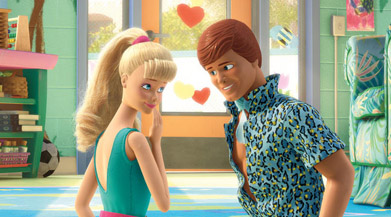Make an Argument
Revisiting Toy Story 3
By Eric Hughes
July 13, 2011
By now, you’ve hopefully realized that Make an Argument is candid, personal and maybe, in a way, informative. What I’ve yet to do with it, though, is own up to a critical wrongdoing on my end.
That’s because when I criticize on BOP, it’s to add weight on the shoulders of silly filmmakers who inadvertently wronged me for greenlighting and/or working on shoddy product.
I don’t know, then, that I’ve taken many chances at reassessing my own opinion. I seem to have enough fun criticizing others’ work instead.
With that said, I’d like to take back anything I might have held against Toy Story 3 - both on this site and to acquaintances in, well, life. My thoughts on the movie were misguided a bit, and I want to clear that air now before another person I know stands next to me with a deer-in-the-headlights look and goes: “Bwaaaah?! You didn’t like Toy Story 3?!”
The whole Toy Story 3 re-evaluation came about in an odd way. So odd that you would probably never guess that I was reintroduced to the movie at a mega church’s Sunday morning service. You see, I’d flown east to spend a long weekend at home, and the church my mother goes to so happened to be in the throes of a three-part series on identifying spiritual themes in blockbuster movies. The movie of the week when I visited was, of course, Toy Story 3.
Not sure about the deal behind use negotiations, but the church showed significant portions of the movie in its hour’s worth of sermon. Like, a lot of the movie. And the clips were a heck of a lot more entertaining than I remember them being. Not too long after, I decided to give Toy Story 3 a second opinion, and did just that.
What had me messed up, I think, was foolishly thinking that much of Toy Story 3’s “point” would come from Andy’s perspective. That expectation ruined my movie experience the first time.
Much of what I’d heard about the movie going in was that it was, in a way, a movie for me and other 20-somethings. You know, we were about the same age as Andy when Toy Story first hit theaters, and now, apparently, Andy had outgrown his toys and would soon head off for college without Woody, Buzz and the rest of it. I was under the impression that his character would be the source for youthful nostalgia.
Now, I’ve been out of college for a few years already, but the overheard storyline resonated with me. I loved that Pixar would be tackling lost, youthful innocence as inevitable aging sets in.
Turns out I had all my eggs in the wrong basket. Andy didn’t factor into the movie nearly as much as I expected him to, and thus, scenes with the toys (i.e. the whole movie) felt like they ran real long. I was waiting for Andy to reappear to ground the film in what it means to grow up.
What I missed, then, was that you get much of that anyway through interactions among the toys as they come to realize they’re no longer as important as they once were.
That whole thing might seem trivial, but when films don’t meet expectations, they can become burdensome to watch. So, watching Toy Story 3 a second time, I had a better idea of what I was going to see, and wasn’t caught off guard by those same, incorrect expectations.
That out of the way, I found myself enjoying Toy Story 3 immensely. It’s rich in comedy and heart, and didn’t suffer so much under the shadow of sequelitis as I claimed it did last time ‘round.
New characters were mostly a delight, and good thing, too, as they underwent the most development. Lotso, as it were, went from the jolly “I’m a hugger!” pink giant to a moody, aggressive baddie. My favorite newbie, though, was the classically trained English dude Woody meets along the way.
Barbies in the movie felt gimmicking in theaters, but I read the characters totally differently in round two. Michael Keaton’s Ken was just golden. The detail I missed in theaters was that Barbie belonged to Andy’s sister before she boxed the toy for donation to Sunnyside. So, Barbie and Ken’s meet up at the play center wasn’t so much a reunion from across the hall, but, perhaps, the first time they’d ever met.
And framing Ken as a metrosexual (if not a closeted homosexual) was inspired. Ken might be male, but we all know he’s a toy for girls.
I’m working off a brain that hasn’t seen a Toy Story in at least a decade, but even then I picked up on a few things included in the movie to mostly treat the fans. I adored “You’ve Got a Friend in Me” playing over the closing credits. And the little green aliens saving the day with a crane – “the claaaaaaw! – was a nice touch, too.
I don’t know that Toy Story 3 is any better than the movies that preceded it – it’s been a long, long while since I last saw them – but it’s a worthy closer to an animated trilogy that doesn’t really have a weak spot.
So often filmmakers – animators or otherwise – mess up part twos in their efforts to re-work the magic of film one in an original way. Or, filmmakers will knock sequel one out of the park – i.e. Shrek 2 – but then lose that momentum in a dangerous way for parts three and beyond. (See, again, the Shrek franchise).
Toy Story, though, is a tight collection of movies that earned its audience - and at a time when Pixar didn’t really have one.




